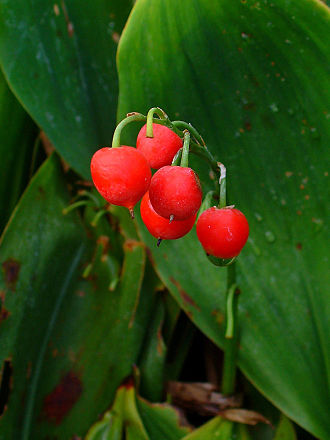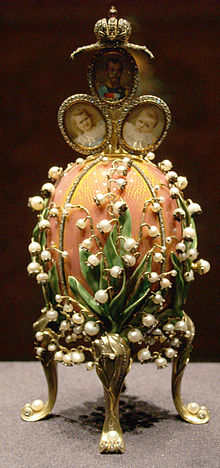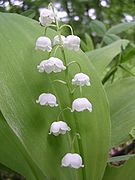No series on poisons would be complete without a mention of lily of the valley (Convallaria majalis), which featured prominently in the TV series Breaking Bad.
In the fourth season of the series, Walter White does away with a drug kingpin by poisoning him with berries from the pretty little potted plant on his patio: lily of the valley.
So is that possible?
You betcha. Lily of the valley contains the same kind of poison found in foxglove (digitalis) and oleander. All parts of the plant are deadly.
Yes. Those pretty little spring flowers, also known as May Bells, May Lily, or Mary’s Tears—which are related to one of my favorite vegetables, asparagus—can be lethal to humans and pets.
Lily of the Valley in Folklore
Traditionally, the tiny white flowers have been considered a symbol of rebirth, and were sacred to Maia, the goddess of spring. Christians consider it a symbol of Christ's resurrection.
 |
| Lily of the Valley is sacred to Maia |
The flowers also have a long history of symbolizing tears. They’re mentioned in the Bible many times, especially in the song of Solomon. They are said to represent the tears of Eve after the banishment from Eden, of Jacob for Rachel and Joseph, and of Mary at the cross.
Other stories connect the flowers with fairies and woodland nymphs. (Fairies find them handy as drinking vessels.) One legend says they protect a garden from evil and the spells of bad witches.
And there’s an English folktale that tells how they sprang up from the blood of a dragon slain by St. Leonard of Sussex.
German and Scandinavian tradition sees them as bringers of good luck.
Muguet de Bois
It was Christian Dior’s favorite flower and his signature perfume Diorissimo strongly features the scent of muguet.
It’s also prized by florists. Kate Middleton, the Duchess of Cambridge had a bouquet of lily of the valley at her wedding to Prince William.
Lily of the Valley Grows in Rainy, Cool Climates
The plant is native to Northern Europe and Eastern Asia. It grows all over northeastern North America, too, although whether it’s native is a subject of debate.
Walter White found it growing in a New Mexico patio garden, where an attentive gardener would have had to keep it in the shade and monitor its watering carefully. It likes well drained, but
 |
| Kate Middleton's bridal bouquet |
I understand why someone would want to grow lily of the valley, even in the desert. The scent is delightful and the tiny flowers are adorable. I loved the carpet of lily of the valley that bloomed under the maple tree in our New England garden when I was as a child. I don’t remember anybody’s parents telling us not to eat it, and luckily none of us tried.
Keep Those Pretty Flowers Away From Children and Pets
Our parents didn’t know any better, but now poison experts recommend that parents and pet owners keep lily of the valley out of their gardens.
The plant is classified as a “1” on the poison scale, which means it’s so toxic it can kill. It is also classified as a “3” because it can cause really nasty rashes.
As little as two leaves can kill a small pet or young child, and more can kill an adult or large animal. Anyone who has swallowed any part of the plant needs to get to a hospital immediately.
Even the water in a vase containing lily of the valley flowers can contain a lethal dose of poison.
The main toxins in Convallaria majalis are convallatoxin, convallamarin, and lokunjoside. All are cardiac glycosides. They also contain saponins, which have been used for millennia as fish poisons, although their effect on humans isn't as powerful.
Symptoms
 |
| The berries Walter White used |
The symptoms are pretty nasty: diarrhea, vomiting, nausea, headache, drooling, rash, heart arrhythmia and then death.
It may be a pretty plant, but it's not going to make a pretty corpse.
What to Do
Lily of the Valley in Traditional Medicine
Like most of the toxic plants I’ve listed in this series, lily of the valley is also used in traditional medicine.
The convallaria chemicals, known as cardiac glycosides, can help the heart if administered very carefully. Like digitalis, it has been used for centuries in European herbal medicine to treat heart conditions like mild heart failure. It improves the efficiency of the heart muscles and takes some of the workload off the heart. In the UK, a tincture of convallaria is legal to buy as a “scheduled” herb.
Lily of the Valley in Crime
 |
| Faberge egg with pearl lilies of the valley |
Lily of the Valley is a popular murder weapon for authors of crime fiction. I think the fact it’s a symbol of purity and such a pretty little flower offers some appealing irony. Obviously the Breaking Bad writers found it a handy weapon for Walter White. And Anne Perry uses it in one of her William Monk novels, Weighed in the Balance.
I’ve read comments by several indie authors recently who planned to use lily of the valley in their WIP.
But I have not been able to find any real-life reports of lily of the valley murders. It probably isn’t a reliable form of poison because the level of toxicity can vary so widely depending on soil and other conditions of the plant’s environment.
Plus the plant almost immediately induces vomiting, so the victim may expel it before the poison starts to work. It also doesn’t accumulate in the body the way heavy metal poisons do, and it has a short ‘half-life’ so the power of the toxins fades fast.
Also, it is detectable with modern scientific methods, so it’s probably more fool-proof in historical mysteries than contemporary ones.
Have you read any mysteries that featured lily of the valley poisoning? Have you heard of any real-life murders using the plant?
I'm wrapping up my poison series. It will be available soon in a handy ebook. Keep tuned for an exciting new series coming in the next couple of months.
Poison Series
Part 39: Bloodroot
On Sale until March 31!
The first three books in THE CAMILLA RANDALL MYSTERIES series:
Ghostwriters in the Sky, Sherwood, Ltd. and The Best Revenge. Three hilarious rom-com mysteries for less than a dollar!!

99c at All the Amazons
Also available at iTunes, and NOOK,
On Sale until March 31!
The first three books in THE CAMILLA RANDALL MYSTERIES series:
Ghostwriters in the Sky, Sherwood, Ltd. and The Best Revenge. Three hilarious rom-com mysteries for less than a dollar!!

99c at All the Amazons
Also available at iTunes, and NOOK,



No comments:
Post a Comment